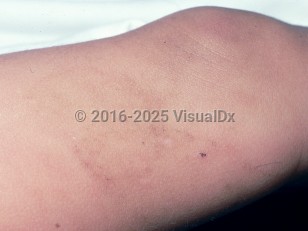Bite marks of child abuse - Suspected Child Abuse
Alerts and Notices
Important News & Links
Synopsis

Bite marks can be a form of abusive injury and are of particular concern because of their potential for infection. Various instruments have been used in child abuse and traditionally leave patterned imprints of their shape on the child's skin. Bite marks should be suspected when ecchymoses, abrasions, or lacerations are found in an elliptical, ovoid, or semicircular pattern.
Common locations for bite marks are on "fleshy" body parts (thighs, buttocks, cheeks), but they can occur anywhere on the body. They have been reported as a form of sexual as well as physical abuse. Bite marks have been documented on both pediatric male and female genitalia but are more commonly found in males.
A human bite typically causes less tissue destruction than that from an animal but has greater potential for infection. Aerobic and anaerobic bacteria commonly colonize the mouth such as Staphylococcus, Streptococcus, and Clostridium. Bite infections are typically polymicrobial.
Childhood physical and sexual abuse is a problem of epidemic proportions affecting children of all ages and economic and cultural backgrounds. Approximately 3.9 million cases of child abuse were investigated in 2020, with victims of substantiated cases numbering approximately 618 000. Although awareness is increasing, it is often challenging to differentiate findings attributable to child abuse from those of other benign skin conditions.
Common locations for bite marks are on "fleshy" body parts (thighs, buttocks, cheeks), but they can occur anywhere on the body. They have been reported as a form of sexual as well as physical abuse. Bite marks have been documented on both pediatric male and female genitalia but are more commonly found in males.
A human bite typically causes less tissue destruction than that from an animal but has greater potential for infection. Aerobic and anaerobic bacteria commonly colonize the mouth such as Staphylococcus, Streptococcus, and Clostridium. Bite infections are typically polymicrobial.
Childhood physical and sexual abuse is a problem of epidemic proportions affecting children of all ages and economic and cultural backgrounds. Approximately 3.9 million cases of child abuse were investigated in 2020, with victims of substantiated cases numbering approximately 618 000. Although awareness is increasing, it is often challenging to differentiate findings attributable to child abuse from those of other benign skin conditions.
Codes
ICD10CM:
T76.12XA – Child physical abuse, suspected, initial encounter
Y04.1XXA – Assault by human bite, initial encounter
SNOMEDCT:
262555007 – Human bite - wound
371779005 – Physical child abuse
T76.12XA – Child physical abuse, suspected, initial encounter
Y04.1XXA – Assault by human bite, initial encounter
SNOMEDCT:
262555007 – Human bite - wound
371779005 – Physical child abuse
Look For
Subscription Required
Diagnostic Pearls
Subscription Required
Differential Diagnosis & Pitfalls

To perform a comparison, select diagnoses from the classic differential
Subscription Required
Best Tests
Subscription Required
Management Pearls
Subscription Required
Therapy
Subscription Required
References
Subscription Required
Last Reviewed:12/12/2022
Last Updated:12/13/2022
Last Updated:12/13/2022
Bite marks of child abuse - Suspected Child Abuse

